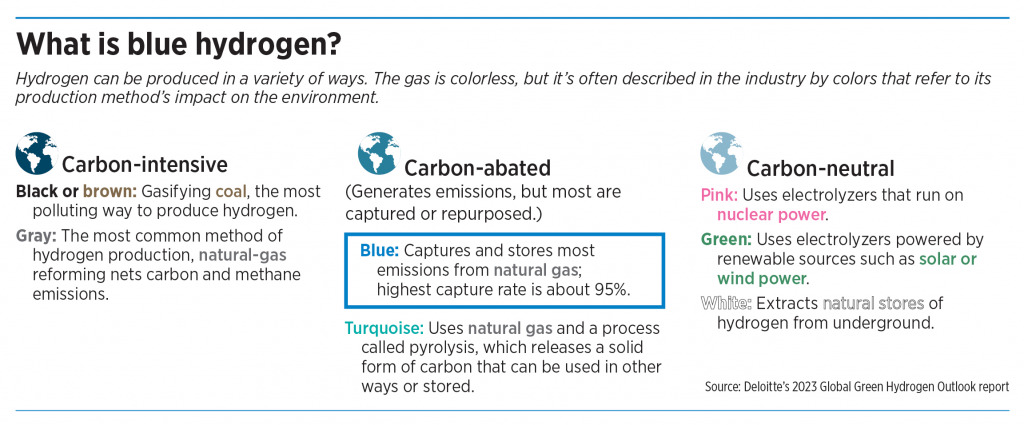Subscriber Benefit
As a subscriber you can listen to articles at work, in the car, or while you work out. Subscribe NowA coalition involving Indiana, Illinois and Michigan is one of seven selected by the Biden Administration for a $7 billion program to establish clean hydrogen hubs across the U.S.
Biden is expected to make the official announcement during an economic-themed visit to Philadelphia on Friday.
Gov. Eric Holcomb’s office says the U.S. Department of Energy will award up to $1 billion in grant funding to the Midwest Alliance for Clean Hydrogen, or MachH2, which consists of more than 70 Midwest public and private organizations.
 In Indiana, those organizations include Energy Systems Network, the Indiana Economic Development Corp., Columbus-based Cummins Inc., Purdue University, London-based BP Plc and others.
In Indiana, those organizations include Energy Systems Network, the Indiana Economic Development Corp., Columbus-based Cummins Inc., Purdue University, London-based BP Plc and others.
The proposed regional hydrogen hub would include the production of so-called blue hydrogen at or near the BP refinery in the northwest Indiana city of Whiting.
Blue hydrogen is produced by converting natural gas into carbon dioxide and hydrogen, with the CO2 being stored underground. The low-carbon hydrogen fuel can be used in a variety of areas, including steelmaking, power generation and agriculture.
“We are ecstatic that Indiana is a beneficiary of this monumental investment,” Holcomb said in a news release. “This funding has the potential to support the unprecedented economic investment proposed by BP that will cement Indiana’s pole position in the new energy economy. This grant could propel forward this project as a critical piece of this new hydrogen ecosystem.
The White House calls clean hydrogen “essential to achieving the president’s vision of a strong clean energy economy” and net-zero greenhouse gas emissions in the U.S. by 2050.
“As a clean fuel, hydrogen complements the role played by other clean energy sources, like wind and solar, to help the U.S. reduce emissions in energy-intensive sectors of the economy: steel and cement production, heavy-duty transportation, and shipping,” the White House said in a statement.
The seven hubs selected by the administration will spur more than $40 billion in private investment and create tens of thousands of good-paying jobs, the White House said, including many high-paying union jobs.
Indiana has already taken steps toward the hydrogen production made possible through the regional hub. In September 2022, Holcomb signed House Enrolled Act 1209 into law, which created a regulatory framework for companies to store captured carbon dioxide underground in Indiana.
With the new law, companies can send captured carbon emissions to the underground caverns via pipelines to be stored.
In an interview with Inside INdiana Business, Energy Systems Network CEO Paul Mitchell said the state was well suited for carbon capture and sequestration.
“Indiana has some underground geology – they’re called saline aquifers, typically – that are robust and really are ideal for carbon capture and sequestration,” said Mitchell. “There are some in the northern part of the state in particular, but there are other pockets of the states where we know these formations exist. It can be really transformational for not only hydrogen production but just carbon capture in general.”
Also that month, Holcomb signed a Memorandum of Understanding with seven other states with the goal of securing federal funds to establish a hydrogen ecosystem in the region.
Nearly every state had joined at least one proposed hub, and many have been working together, hoping to reap the economic development and thousands of jobs they would bring. Big fossil fuel companies, renewable energy developers and researchers in university and government labs are involved, too.
Environmental groups are skeptical, arguing that while hydrogen is a clean-burning source of power, it takes a great deal of energy to produce. When it’s made with electricity from coal or natural gas, it has a bigger carbon footprint than simply burning the source fuel.
“Hydrogen is another bait-and-switch from an administration that continues to break its promises to aggressively tackle climate change and help communities achieve a just, equitable transition to renewable energy,” said Silas Grant, a campaigner with the environmental group Center for Biological Diversity.
Holcomb’s office says the award from the DOE is “an acknowledgement that the Midwest possesses all the components critical for a successful hydrogen economy, including new opportunities to incorporate hydrogen into existing and new manufacturing processes.”
Please enable JavaScript to view this content.
